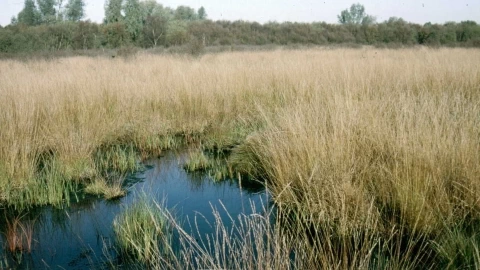Holcroft Moss, near Warrington in Cheshire, is a 19-hectare (47 acres) Site of Special Scientific Interest (SSSI), part of Manchester Mosses, a European Union designated Special Area of Conservation.[1][2] The word moss, first used during the 15th century,[3] is the local name for a lowland peat bog.[4]
As with large parts of neighbouring Chat MossLarge area of peat bog that makes up 30 per cent of the City of Salford, in Greater Manchester, England and Carrington MossLarge area of peat bog near Carrington in Greater Manchester, England. Originally an area of grouse moorland, it was reclaimed in the latter half of the 19th century for farming and the disposal of Manchester's waste., Holcroft Moss began to form during the Flandrian period, from 7100 to 5000 BCE.[5] Although the moss is the only known area of lowland bog in Cheshire that has not been cut for peat, commercial peat extraction from the bog’s immediate surroundings has lowered the water table, and thus degraded the moss. The Cheshire Wildlife Trust has attempted to improve the site’s hydrology by inserting sheets of plastic piling around its perimeter.[6]
Pollution
A 2018 study showed that the top layer of peat in the moss is contaminated by high levels of lead and copper, most of which was deposited during the late 19th to early 20th century. That time period corresponds with the Victorian peak of coal-powered industry, and with the nearby copper-smelting works in Warrington, St Helens and Liverpool.[7]
The pollution has altered the ecology of the bog, but removing the affected peat layer is considered to be impractical. It is hoped that by re-wetting the area, new peat will cover the polluted layer, a process that may take up to 100 years.[8]
Flora and fauna
The moss is surrounded by a wooded fringe containing birch, willow and bracken (Pteridium aquilinum).[7]
Cross-leaved heath, cranberry, cottongrass and six species of sphagnum moss are also present on the site, which is home to a small population of common lizard (Zootoca vivipara).[6] Holcroft Moss is also the site of the first sighting in the UK of the rare jumping spider (Sibianor larae), reported in 2018.[9]


